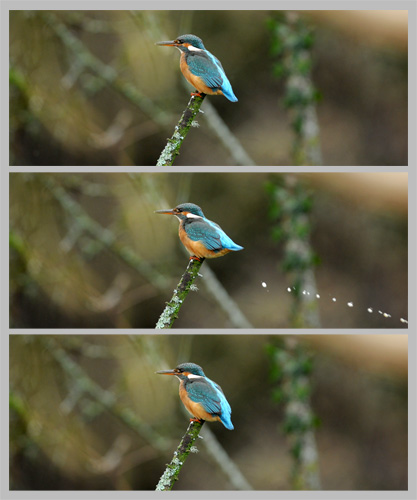
I was at the feeding station today and all the regulars were present. On the way to the hide a Peregrine flew over, the fourth record for the Farm. The water level has dropped allowing the route through the river to be taken. Over the last few weeks the only way to the hide has been over the railway. The cows are all in for the winter now, so no chance of an unpleasant encounter! Last year Richard was unceremoniously dumped into the river as he tried to pass them under the bridge. They were a little frisky early on in the year but had settled down latterly.
A really drab day today, but not so cold as it has been. The Kingfisher was around a fair amount of the time, but mostly in amongst the mass of branches that spread out over the pond, dropping in to the water on a regular basis, bringing up small fish and then skulking low over the ponds again deep in the undergrowth. Despite its vivid plumage, it is surprisingly camouflaged when sitting low, the orange particularly blending into the lichen and moss on the trees. Next summer, when the water is low, I’ll bang a few fence posts in to the middle of the pond. I would have done it this year but I didn’t realise how much the Kingfisher used the pond; I had assumed it would favour the river, which is only a stones throw away, or move down to the estuary.
A couple of hours in to the session and soon after a Sparrowhawk had flown through the feeding area, not four feet from the hide, the familiar sharp call of the Kingfisher announced its arrival on a branch right in front of me and just below the feeders, about ten yards away. It stayed long enough for me to lock on, and as is evident from the series of images, have a shit! I was lucky to catch the moment, it happens in an instant, the tail lifts up and out it comes, with a fair degree of force! It was also lucky that the branch she (the underside of the bill is redish, denoting a female) landed on, has formed a triangle with the far branch, which is out of focus and the bottom of the image. The Kingfisher sits on the apex of the triangle in the centre of the frame and is very much the focal point of the image.
The series was taken with a 300mm 2.8 lens. When the light is as poor as it was today there is little choice other than the smaller focal length lens and wider aperture. It is also good to vary the lens on occassions as it demands a different approach and changes the look of the image, giving a greater amount of space around the birds and placing them in a wider environmental context, something I really enjoy doing.
I may yet, try to bang a few posts into the edge of the pond this year, you never know and next summer is, after all, a long way off!
